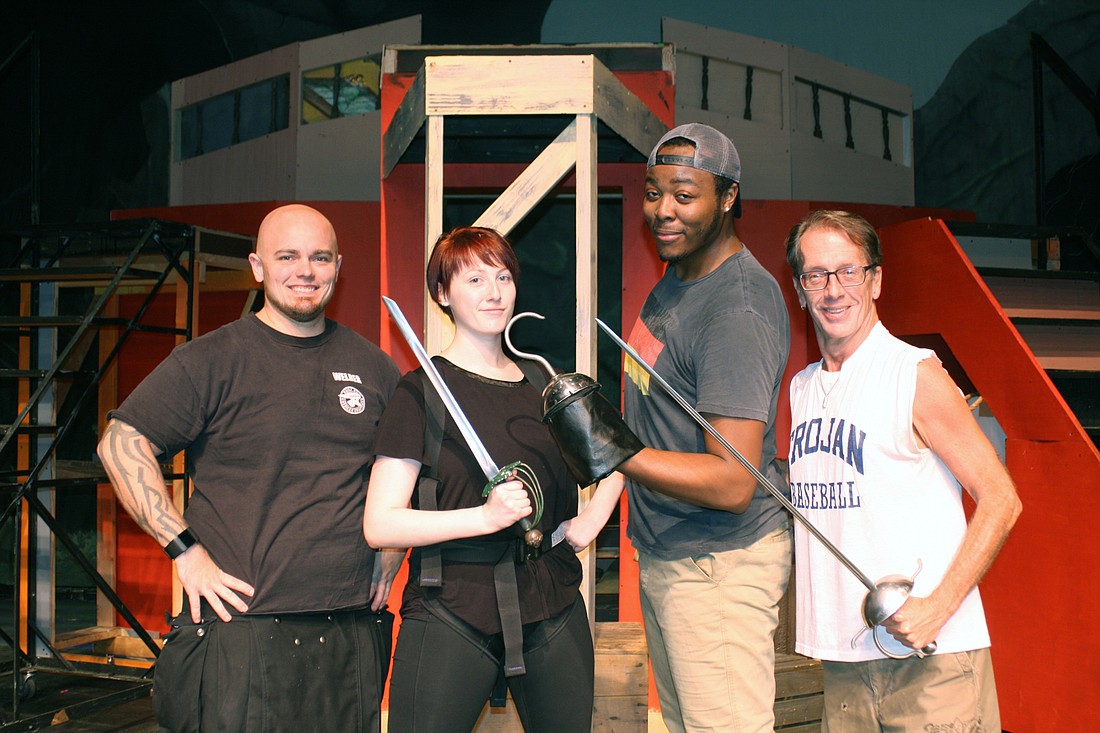- May 19, 2025
-
-
Loading

Loading

Ah, who hasn’t dreamed of flying? Along with perpetual youth, it’s probably one of humanity’s oldest fantasies. Both dreams are at the heart of “Peter Pan,” opening this week at Venice Theatre.
Yes, it looks like magic. The truth is, unless you’re dreaming, unpowered human flight takes experience, talent, sophisticated technology and a lot of hard work.
Pre-flight preparation is underway when I arrive at the theater. John Andzulis, the theater’s technical director, leads the way to the stage. Director Brad Wages, flight director Terry Nelson, Savannah Sinclair (Peter Pan) and Nethaneel Williams (Captain Hook) are already there. The flight crew is out of sight, and the scene is in progress.
Hook: “Proud and insolent youth, prepare to meet thy doom!”
Pan: “Dark and sinister man, have at thee!”
Wages begins clapping his hands and counting out a beat, and the clacking swordplay begins.
Hook swings his hook at Pan in a dirty move. It gets stuck in a block of wood. Gallant Pan doesn’t skewer him while he’s helpless, but gives his backside a whack with the flat of his sword. Hook frees himself and gives chase. Pan flies away, spins back, sword aimed for Hook’s heart. The pirate parries.
And that’s it. End scene. Take five. According to Andzulis, the scene is more than spectacle; it’s storytelling.
“My job is to serve the story,” he says. “‘Peter Pan’ is a story about a boy who can fly and doesn’t grow up — who teaches other kids to fly. Ideally, that’s what you see, and the technical side stays invisible.”
The play’s the thing, sure. What goes on backstage is a thing too, and the cast is learning it all. As Andzulis sees it, Venice Theatre’s summer stock program is basically theater boot camp.
“Some talented young adults come together and master a lot of skills, including the art of flying,” he says. “We teach the actors how to hold their bodies, how to shift in the air.”
These skills can be taught, if the actors have what it takes. This goes beyond knowledge; athleticism is a must. Having a strong core helps, but above all the actors need to be flexible.
Nelson serves the story, too. He’s a Ronin talent who wanders the country working for ZFX, a theatrical effects company based out of Louisville, KY. He oversees the Venice Theatre flight crew, consults with Andzulis and Wages and makes sure everybody knows what they’re doing and everything works. He explains that each flying actor wears a harness with a quick-release, metal backplate. This snaps onto a cable, connected to tracks and pulleys in an overhead framework. The flight crew holding the other end of the cable supports about two-thirds of the actor’s weight; the performer supplies the momentum.
“The wires supporting the actors are much thinner than the ones in Mary Martin’s day,” he says. “Ideally, you won’t notice them at all.”
And the five minutes are up. The actors take positions and draw their swords.
The previous scene repeats again and again. Wages counts the beat and critiques the scene. They lose the hook-stuck-in-the-post gag and refine the arc of Pan’s flight. Right now, Sinclair swoops in for the kill, overshoots and winds up facing the wrong way. She tries to correct herself, but it doesn’t work.
“You see what happened?” says Nelson. “Flying isn’t like swimming.”
They refine the attack. This time, Pan sweeps back nicely. Sinclair’s a quick study.
The clapping, counting and swordplay continues. At some point, somebody starts playing the piano. Wages, Andzulis, and Nelson confer with the actors, bouncing suggestions off each other. Scene after scene, the free-form, collaborative brainstorming goes on. And each run is a little better than the last.
After an hour of this, it’s time for another break. Summer rain is pouring like BBs on the theater roof. The young actors don’t even look tired. They don’t mind a few questions.
Sinclair’s not afraid of flying. She’s done it once before, in “The Little Mermaid,” at Manatee Performing Arts Center. The mock swordplay is new, and she loves it.
“It feels fierce and cool,” she says. She credits director Wages and Peter Ivanov for the “awesome” fight choreography.
Taking flight as Peter Pan has stretched her performing abilities and helped her add a new type of character to her range.
“I’m pretty girly and usually play girly characters,” she says. “Playing a boy is a fun challenge.”
And Williams, an acting intern at the theater, is having fun, too.
“Who wouldn’t want to be a pirate?” he says with a laugh. “But Pan can fly, and I can’t. It’s unfair! Hook keeps saying that, and I can really see his point.”
Sinclair smiles and shrugs, as if to say, “Neverland’s not fair.”
Break time is almost over. Hours of painstaking attention to detail lie ahead. They’re still refining this one bit. The final sequence will last just 40 seconds, but Nelson says the preparation will be worth it. In the end, it won’t look like work. And that’s the point.
Wages claps out a beat. The actors take positions and draw their swords.
Hook: “Proud and insolent youth, prepare to meet thy doom!”
And the fight is on.